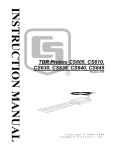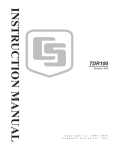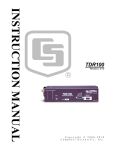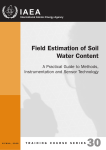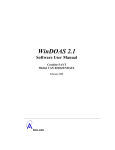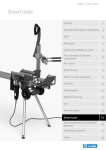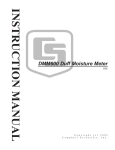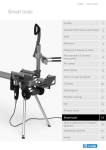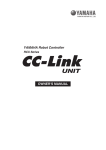Download Campbell TDR Product manual
Transcript
TDR Probes CS605, CS610, CS630, CS635, CS640, CS645 Revision: 9/13 C o p y r i g h t © 2 0 0 6 - 2 0 1 3 C a m p b e l l S c i e n t i f i c , I n c . Warranty “PRODUCTS MANUFACTURED BY CAMPBELL SCIENTIFIC, INC. are warranted by Campbell Scientific, Inc. (“Campbell”) to be free from defects in materials and workmanship under normal use and service for twelve (12) months from date of shipment unless otherwise specified in the corresponding Campbell pricelist or product manual. Products not manufactured, but that are re-sold by Campbell, are warranted only to the limits extended by the original manufacturer. Batteries, fine-wire thermocouples, desiccant, and other consumables have no warranty. Campbell’s obligation under this warranty is limited to repairing or replacing (at Campbell’s option) defective products, which shall be the sole and exclusive remedy under this warranty. The customer shall assume all costs of removing, reinstalling, and shipping defective products to Campbell. Campbell will return such products by surface carrier prepaid within the continental United States of America. To all other locations, Campbell will return such products best way CIP (Port of Entry) INCOTERM® 2010, prepaid. This warranty shall not apply to any products which have been subjected to modification, misuse, neglect, improper service, accidents of nature, or shipping damage. This warranty is in lieu of all other warranties, expressed or implied. The warranty for installation services performed by Campbell such as programming to customer specifications, electrical connections to products manufactured by Campbell, and product specific training, is part of Campbell’s product warranty. CAMPBELL EXPRESSLY DISCLAIMS AND EXCLUDES ANY IMPLIED WARRANTIES OF MERCHANTABILITY OR FITNESS FOR A PARTICULAR PURPOSE. Campbell is not liable for any special, indirect, incidental, and/or consequential damages.” Assistance Products may not be returned without prior authorization. The following contact information is for US and international customers residing in countries served by Campbell Scientific, Inc. directly. Affiliate companies handle repairs for customers within their territories. Please visit www.campbellsci.com to determine which Campbell Scientific company serves your country. To obtain a Returned Materials Authorization (RMA), contact CAMPBELL SCIENTIFIC, INC., phone (435) 227-9000. After an application engineer determines the nature of the problem, an RMA number will be issued. Please write this number clearly on the outside of the shipping container. Campbell Scientific’s shipping address is: CAMPBELL SCIENTIFIC, INC. RMA#_____ 815 West 1800 North Logan, Utah 84321-1784 For all returns, the customer must fill out a “Statement of Product Cleanliness and Decontamination” form and comply with the requirements specified in it. The form is available from our web site at www.campbellsci.com/repair. A completed form must be either emailed to [email protected] or faxed to (435) 227-9106. Campbell Scientific is unable to process any returns until we receive this form. If the form is not received within three days of product receipt or is incomplete, the product will be returned to the customer at the customer’s expense. Campbell Scientific reserves the right to refuse service on products that were exposed to contaminants that may cause health or safety concerns for our employees. Table of Contents PDF viewers: These page numbers refer to the printed version of this document. Use the PDF reader bookmarks tab for links to specific sections. 1. Introduction .................................................................1 2. Cautionary Statements...............................................1 3. Initial Inspection .........................................................1 4. Overview......................................................................1 5. Specifications .............................................................2 5.1 5.2 5.3 Physical Description.............................................................................2 Measurement Parameters .....................................................................2 Electromagnetic Compatibility ............................................................3 6. Installation ...................................................................3 7. Operation .....................................................................3 7.1 Probe Offset for Water Content Measurement.....................................3 7.1.1 Calculating Probe Offset...............................................................3 7.2 Probe Constant for Electrical Conductivity Measurement ...................4 7.2.1 Electrical Conductivity Error from Attenuation............................4 7.3 Water Content Measurement Error from Cable ...................................4 7.4 Water Content Measurement Error from Soil Electrical Conductivity .....................................................................................5 8. References ..................................................................7 Appendices A. Discussion of TDR Probe Offset and a Simple Laboratory Method for Calculation ..................... A-1 A.1 A.2 Discussion of Probe Offset.............................................................. A-1 The Compounding Effect of Signal Attenuation in Connecting Cables .......................................................................................... A-2 A.3 Method for Calculating Probe Offset Using Information from the Terminal Mode of PC-TDR......................................................... A-3 A.3.1 Procedure for Calculating Probe Offset ................................... A-3 A.3.2 An Example Using CS605 ....................................................... A-4 i Table of Contents B. Correcting Electrical Conductivity Measurements for System Losses......................B-1 B.1 B.2 Description of Method..................................................................... B-1 Detailed Method Description........................................................... B-2 B.2.1 Collecting Reflection Coefficient with Probes Open and Shorted.................................................................................. B-2 B.2.2 Determining Kp ........................................................................ B-2 B.2.3 Deriving Calibration Function.................................................. B-3 B.2.4 CR1000 Program for Collecting ρopen and ρshorted Values ......... B-4 7-1. Waveforms collected in a sandy loam using CS610 probe with RG8 connecting cable. Volumetric water content is 24% and bulk electrical conductivity is 0.3 dS m-1......................................... 5 Waveforms collected in a sandy loam using CS610 probe with RG8 connecting cable. Volumetric water content values are 10, 16,18, 21 and 25%. Solution electrical conductivity is 1.0 dS m-1. ................. 6 Waveforms collected in a sandy loam using CS610 probe with RG8 connecting cable. Volumetric water content values are 10, 18, 26, 30 and 37%. Solution electrical conductivity is 10.2 dS m-1................. 6 Example of start of TDR probe determination ................................ A-2 Example of corrected and uncorrected electrical conductivity values. .......................................................................................... B-3 Figures 7-2. 7-3. A-1. B-1. Tables 5-1. 5-2. A-1. B-1. TDR Probe Physical Properties ........................................................... 2 TDR Probe Measurement Properties ................................................... 2 Dielectric permittivity values for range of temperatures. From equation [A5]. .............................................................................. A-5 Standard KCl Solutions ................................................................... B-2 ii TDR Probes CS605, CS610, CS630, CS635, CS640, CS645 1. Introduction This document presents descriptions and instructions for Campbell Scientific Time Domain Reflectometry (TDR) probes and includes some TDR principles. Consult the TDR100 operating manual for comprehensive TDR instructions. A single TDR probe can be connected directly to the TDR100 or multiple probes connected via the SDMX50-series Coaxial Multiplexers. Before using the TDR probes, please study: • • 2. 3. 4. Section 2, Cautionary Statements Section 3, Initial Inspection Cautionary Statements • Care should be taken when opening the shipping package to not damage or cut the cable jacket. If damage to the cable is suspected, consult with a Campbell Scientific application engineer. • The CS605 and CS610 are shipped with rubber caps covering the sharp ends of the rods. Remove the three caps before use. • The TDR100 is sensitive to electrostatic discharge damage. Avoid touching the center conductor of the panel BNC connector or the center rod of TDR probes connected to the TDR100. Initial Inspection • Upon receipt of a TDR probe, inspect the packaging and contents for damage. File damage claims with the shipping company. • The model number and cable length are printed on a label at the connection end of the cable. Check this information against the shipping documents to ensure the correct product and cable length are received. Overview TDR probes are the sensors of the TDR measurement system and are inserted or buried in the medium to be measured. The probes are a wave guide extension on the end of coaxial cable. Reflections of the applied signal along the waveguide will occur where there are impedance changes. The impedance value is related to the geometrical configuration of the probe (size and spacing of rods) and also is inversely related to the dielectric constant of the surrounding material. A change in volumetric water content of the medium surrounding the probe causes a change in the dielectric constant. This is seen 1 TDR Probes CS605, CS610, CS630, CS635, CS640, CS645 as a change in probe impedance which affects the shape of the reflection. The shape of the reflection contains information used to determine water content and soil bulk electrical conductivity. 5. Specifications 5.1 Physical Description TABLE 5-1. TDR Probe Physical Properties Probe Model Rods Probe Head Cable Type CS605 length 30.0 cm diameter 0.475 cm length width thickness 10.8 cm 7.0 cm 1.9 cm RG58 CS610 length 30.0 cm diameter 0.475 cm length width thickness 10.8 cm 7.0 cm 1.9 cm RG8 low loss CS630 length 15.0 cm diameter 0.318 cm length width thickness 5.75 cm 4.0 cm 1.25 cm RG58 CS635 length 15.0 cm diameter 0.318 cm length width thickness 5.75 cm 4.0 cm 1.25 cm LMR-200 low loss CS640 length diameter 7.5 cm 0.159 cm length width thickness 4.5 cm 2.2 cm 1.0 cm RG58 CS645 length diameter 7.5 cm 0.159 cm length width thickness 4.5 cm 2.2 cm 1.0 cm LMR-200 low loss 5.2 Maximum Soil Bulk Electrical Conductivity Maximum Cable Length (measured from the tips of the probe’s rods to the TDR100 Reflectometer) 1.4 dS/m 15 m 1.4 dS/m 25 m 3.5 dS/m 15 m 3.5 dS/m 25 m 5.0 dS/m 15 m 5.0 dS/m 25 m Measurement Parameters TABLE 5-2. TDR Probe Measurement Properties 2 Probe Model Probe Offset (meters) Probe Constant for Electrical Conductivity (EC) Measurement, Kp (using this constant will provide EC in siemens/meter) CS605 and CS610 0.090 1.74 CS630 and CS635 0.052 3.36 CS640 and CS645 0.035 6.40 TDR Probes CS605, CS610, CS630, CS635, CS640, CS645 5.3 Electromagnetic Compatibility All TDR probes are compliant with performance criteria available upon request. RF emissions are below EN55022 limit. 6. Installation TDR probes can be installed in any orientation: horizontally, vertically, or at an angle to the surface. The measured water content is the integral or average of the water content over the length of the probe rods. The probe rods should be completely surrounded by the soil or other media being measured. If portions of the probe rods are exposed to air, the algorithm for analyzing the waveform reflection may not be able to correctly locate the beginning and end of the probe rods. Care must be exercised when inserting probe rods into the soil to minimize soil compaction around the rods. Compaction can leave air voids along the length of the rods. The region adjacent to the rod is the most sensitive so voids near the rods can be a significant source of error. After the soil is disturbed for probe installation, most soils will experience rejuvenation of the soil structure with wetting/drying cycle and freeze/thaw cycles. TDR probes can be buried or inserted into the soil. The CS605G Installation Guide should be used when inserting the CS605 and CS610 into the material being measured. A guide is generally not needed for the smaller diameter probes. 7. Operation 7.1 Probe Offset for Water Content Measurement A portion of the TDR probe rods is surrounded by the probe head material and is not exposed to the material being measured. Probe offset is used to correct for this. TABLE 5-2 lists offset values for probes manufactured by Campbell Scientific. These values are entered in the datalogger instruction or in the PCTDR software. 7.1.1 Calculating Probe Offset Probe offset can be calculated using information from PC-TDR. The probe rods are immersed in water of known temperature, algorithm values are collected in the terminal emulator mode of PC-TDR, and simple calculations provide custom offset values. See Appendix A, Discussion of TDR Probe Offset and a Simple Laboratory Method for Calculation, for calculation method. The values listed in TABLE 5-2 were determined using TDR probes with short cables. The shape of the waveform reflection is affected as cable length increases, and this can introduce error into the water content measurement. Using probe offsets determined by the method described in Appendix A, Discussion of TDR Probe Offset and a Simple Laboratory Method for 3 TDR Probes CS605, CS610, CS630, CS635, CS640, CS645 Calculation, with all cabling from TDR100 to probe in place will compensate for the cable losses. Probe offset values obtained this way will be greater than those listed in TABLE 5-2. 7.2 Probe Constant for Electrical Conductivity Measurement The electrical conductivity measurement requires a probe constant to account for probe geometry. The probe constant is commonly referred as Kp. The probe constant is entered as a multiplier in the datalogger instruction for TDR100 EC measurement. Kp is set in PC-TDR using Settings/Calibration Functions/Bulk Electrical Conductivity. Using the Kp values in TABLE 5-2 will give electrical conductivity in the units siemens/meter. For the more common units of decisiemens/meter, multiply the TABLE 5-2 Kp values by 10. Probe constant can be calculated using PC-TDR. Selecting Settings/Calibration Functions/Bulk Electrical Conductivity will present a button to Measure Cell Constant. The method requires submersion of the TDR probe rods in de-ionized water of known temperature. See PC-TDR HELP for simple instructions. It is recommended to make several Kp determinations and use the average value. Probe constant can also be calculated using the method presented in Appendix B, Correcting Electrical Conductivity Measurements. This method accounts for signal losses in system cabling and multiplexers. 7.2.1 Electrical Conductivity Error from Attenuation Attenuation of the applied and reflected signal in the cable and multiplexers will affect the accuracy of the electrical conductivity measurement. For accurate electrical conductivity measurements, this attenuation must be accounted for. A paper published by Castiglione and Shouse (2003) describes the error and a method to account for the error. The method requires electrical conductivity measurement with the probes in air and with the rods shorted with all system components in place (cable and multiplexers). Appendix B, Correcting Electrical Conductivity Measurements, presents a summary of the Castiglione and Shouse (2003) method and an adaptation of the method for the TDR100 system. 7.3 Water Content Measurement Error from Cable The determination of water content using the TDR system relies on the evaluation of a pulse reflection from the TDR probe. The pulse generated by the TDR100 and its reflections are subject to distortion during travel between the TDR100 and the TDR probe. The cable connecting the probe to the reflectometer has a characteristic impedance resulting in both resistive and reactive losses. Distortion of the waveform caused by cable impedance can introduce error into the water content determination. FIGURE 7-1 presents waveforms collected from a 3-rod probe (CS610) for various cable lengths. As cable length increases, the rise time and the amplitude of the reflection are affected. The slopes and extrema used by the 4 TDR Probes CS605, CS610, CS630, CS635, CS640, CS645 datalogger algorithm to analyze the waveform are shifted by the cable losses resulting in error. For the data shown in FIGURE 7-1, the water content measurement using the 66 meter cable was in error by about 1.5% volumetric water content when electrical conductivity is low. However, in saline soils, the error can be several percent. See Bilskie (1997) for complete results of the study. 16 meter cable 26 meter cable 45 meter cable 66 meter cable FIGURE 7-1. Waveforms collected in a sandy loam using CS610 probe with RG8 connecting cable. Volumetric water content is 24% and bulk electrical conductivity is 0.3 dS m-1. In general, water content is overestimated with increasing cable length. A calibration of volumetric water content with apparent dielectric constant for a given cable length can improve accuracy. Measurement precision at longer cable lengths will be maintained as long as soil electrical conductivity does not prevent a reflection from the end of the probe rods. This is discussed later in this section. Minimizing cable lengths should always be considered in the design of a measurement system using TDR. If long cable lengths are necessary, the adverse effects can be minimized by using low attenuation cable such as RG8 or LMR-200. Careful probe design ensures correct probe impedance giving robust reflections. 7.4 Water Content Measurement Error from Soil Electrical Conductivity The signal at the probe will be attenuated when ionic conduction occurs in the soil solution. This inherent attenuation is used in TDR measurements to determine soil electrical conductivity as described by equation [5] in the TDR100 manual. The presence of ions in the soil solution provides a path for electrical conduction between TDR probe rods. The attenuation of the signal 5 TDR Probes CS605, CS610, CS630, CS635, CS640, CS645 can affect the accuracy and resolution of water content measurements. FIGURE 7-2 presents a series of waveforms when a solution with an electrical conductivity of 1.0 dS m-1 is added to a soil which has essentially no salt present. FIGURE 7-3 shows data for solution with high electrical conductivity. water content = 9.5% water content = 25% FIGURE 7-2. Waveforms collected in a sandy loam using CS610 probe with RG8 connecting cable. Volumetric water content values are 10, 16,18, 21 and 25%. Solution electrical conductivity is 1.0 dS m-1. water content = 18% water content = 37% FIGURE 7-3. Waveforms collected in a sandy loam using CS610 probe with RG8 connecting cable. Volumetric water content values are 10, 18, 26, 30 and 37%. Solution electrical conductivity is 10.2 dS m-1. 6 TDR Probes CS605, CS610, CS630, CS635, CS640, CS645 The combined effect of long cable runs and high soil electrical conductivity must be considered when TDR measurements are taken. 8. References Bilskie, Jim. 1997. “Reducing Measurement Errors of Selected Soil Water Sensors.” Proceedings of the International Workshop on Characterization and measurement of the hydraulic properties of unsaturated porous media. 387396. Castiglione, P. and P.J. Shouse. 2003. The effect of ohmic cable losses on time-domain reflectometry measurements of electrical conductivity. Soil Sci Soc Am J 2003 67: 414-424. 7 TDR Probes CS605, CS610, CS630, CS635, CS640, CS645 8 Appendix A. Discussion of TDR Probe Offset and a Simple Laboratory Method for Calculation A.1 Discussion of Probe Offset Probe offset accounts for the segment of the TDR probe rods that is part of the probe head and is not exposed to the media surrounding the probe rods. The location of the beginning of the probe that is calculated in the TDR100 operating system is the point along the cable where the transition from the 50 ohm cable to the TDR probe impedance occurs. The distance from this transition to the point where the rods come out of the probe head is constant and can be accounted for. The TDR100 operating system uses the following equation to calculate the ratio of apparent rod length to actual rod length, La/L. This ratio is equal to the square root of dielectric permittivity, La = L ε. end − start − ProbeOff Vp L La apparent length (m) L actual rod length (m) Vp relative propagation velocity (1.0) ProbeOff probe offset (m) start distance into window for beginning of rods (m) end distance into window for end of rods (m) [A1] To examine the sensitivity of La/L to probe offset, multiply equation [A1] by L and take the 1st derivative of La with respect to probe offset. ⎛ end − start ⎞ d ⎜ − ProbeOff ⎟ = −1 ⎟ d(ProbeOff) ⎜⎝ Vp ⎠ [A2] The sensitivity of the apparent length measurement, La, is directly related to probe offset. A probe offset difference of 0.005 changes La by –0.005. The water content error for saturated soil is 0.16% volumetric water content. In very dry soil the error is 0.20%. There is a slight dependence of probe offset on water content but the amount is within the resolution of the water content measurement. A-1 Appendix A. Discussion of TDR Probe Offset and a Simple Laboratory Method for Calculation A.2 The Compounding Effect of Signal Attenuation in Connecting Cables The probe offset values provided in the operating manual were calculated from measurements in the Campbell Scientific soils laboratory. The method is described below. The length of cable for the laboratory calculations was 3 meters or less. As cable length increases, signal loss occurs in both amplitude and bandwidth. As a result of bandwidth loss, the slope of the waveform at the beginning of the probe decreases with increasing cable length. The probe start is determined from the intersection of a line tangent to the waveform at the steepest point and of a line that is essentially horizontal. See FIGURE A-1. The probe offset correction identifies the location where the rods exit the probe head. calculated and corrected start 0.4 reflection coefficient indexstartindexstartcorr 0.2 15 20 25 30 35 40 0.2 0.4 data point horizontal line waveform tangent line FIGURE A-1. Example of start of TDR probe determination The slope of the tangent line decreases as cable length increases, and the intersection of the two lines will shift in the direction of greater apparent probe rod length. Calculating the probe offset using the method described below and with all cables and multiplexers in place will optimize the accuracy of water content measurements. A-2 Appendix A. Discussion of TDR Probe Offset and a Simple Laboratory Method for Calculation A.3 Method for Calculating Probe Offset Using Information from the Terminal Mode of PC-TDR Letting Vp = 1 and solving [1] for ProbeOffset gives: ProbeOff = end − start − La [A3] The start and end distance values are determined by an algorithm in the TDR100 operating system. The apparent length, La, excluding the offset, is related to actual rod length and permittivity by: La := L • ε(T ) [A4] The rod length, L, is the physical length of the rods (m). For 3-rod TDR probes with longer outer rods, the length of the outer rods is used. The dielectric permittivity of water can be calculated from water temperature using: [ ε (T ) := 78.54 • 1 − 4.5791 • 10 −3 • (T − 25 ) + 1.19 • 10 −5 • (T − 25 )2 − 2.8 • 10 −8 • (T − 25 )3 ] [A5] TABLE A-1 contains dielectric permittivities for a typical range of temperatures and may be used in lieu of equation [A5]. Substituting the calculation of La using equations [A4] and [A5] into equation [A3] leaves the end and start distances as the only unknowns. These values can be acquired directly from the TDR100 algorithm by using the terminal emulator mode of PC-TDR. A.3.1 Procedure for Calculating Probe Offset Connect all cabling and multiplexers to be used for field or laboratory measurements. Immerse the TDR probe rods in DI or tap water. The container must be large enough to ensure rods are at least 5 cm from container walls. Use PC-TDR as follows: 1. Enter values for Waveform parameters. Suggested values are: Average = 4, Points = 251. Relative propagation velocity, Vp, must be 1. Choice of start point and waveform length depends on the length of the cable and the actual probe rod length. There should be about 0.5 meters before the probe, enough distance for probe apparent length in water (approximately 9 times rod length), and enough distance for the waveform past the end of the probe. The distance for the end can be approximated as 3 times rod length. 2. Enter the value for Probe Rod Length in meters and set Probe Offset to 0 m. 3. Click the Water Content button to send the values to the TDR100 and to have it calculate La/L and provide start and end values. A-3 Appendix A. Discussion of TDR Probe Offset and a Simple Laboratory Method for Calculation 4. Enter Terminal Mode using Options/Terminal Emulator. 5. Press Enter until > appears 6. Type GVAR then Enter. 7. It is recommended that step 6 be repeated several times and that the average values of Start and End be used for following calculations. (the line commands are not case sensitive) GVAR returns the uncorrected Start and End. These values must be converted to distance from index values. This is done as follows: start distance := start • WaveformLength datapoints − 1 end distance := end • WaveformLength datapoints − 1 Equations [A3] and [A4] are then used to calculate probe offset. A.3.2 An Example Using CS605 • Measured TDR probe rod length: L := 0.3 m. • Measure temperature of water in column T := 24.4°C . • Determine actual dielectric permittivity of water using following equation or values in TABLE A-1. ε(T ) := 78.54 • ⎡1 − 4.5791 •10 − • (T − 25) + 1.19 •10 −5 • (T − 25)2 − 2.8 •10 −8 • (T − 25)3 ⎤ ⎢⎣ ⎥⎦ 3 ε(T ) = 78.76 La := L • ε(T ) La = 2.66 m • Waveform parameters for PC-TDR WindowLength := 5 m datapoints := 251 Probe length = 0.3 m Probe offset = 0 m • Start and end index values from terminal emulator mode of PC-TDR as described above start index := 32.44 • end index := 169.87 converting waveform index to apparent distance start distance := A-4 Vp := 1.0 start index • WindowLength datapoints − 1 Appendix A. Discussion of TDR Probe Offset and a Simple Laboratory Method for Calculation end distance := end index • WindowLength datapoints − 1 start distance = 0.65 Pr obeOffset := end distance = 3.4 ( − La • Vp − end distance + start distance ) Vp ProbeOffset = 0.086 TABLE A-1. Dielectric permittivity values for range of temperatures. From equation [A5]. Temperature (°C) Dielectric Permittivity 15 82.23 15.5 82.04 16 81.85 16.5 81.67 17 81.48 17.5 81.29 18 81.1 18.5 80.92 19 80.73 19.5 80.55 20 80.36 20.5 80.18 21 79.99 21.5 79.81 22 79.63 22.5 79.44 23 79.26 23.5 79.08 24 78.9 24.5 78.72 25 78.54 25.5 78.36 26 78.18 26.5 78 A-5 Appendix A. Discussion of TDR Probe Offset and a Simple Laboratory Method for Calculation TABLE A-1. Dielectric permittivity values for range of temperatures. From equation [A5]. A-6 Temperature (°C) Dielectric Permittivity 27 77.82 27.5 77.65 28 77.47 28.5 77.29 29 77.12 29.5 76.94 30 76.76 Appendix B. Correcting Electrical Conductivity Measurements for System Losses TDR system cabling and multiplexers introduce losses of the applied and reflected signals which can lead to error in measurement of electrical conductivity. The following information is based on a method presented in paper published by Castiglione and Shouse (2003). The method has been tested by Campbell Scientific and found to provide excellent results. Refinement of the method is provided to allow implementation using Campbell Scientific dataloggers and TDR100 system. B.1 Description of Method The method is essentially a calibration and involves collecting system characterization measurements with all system components in place; TDR100, multiplexers, all cabling, and probes. The steps in the process are: 1. measure reflection coefficient with probe rods open and with probe rods shorted 2. determine probe constant, Kp, using one solution of known electrical conductivity 3. use values collected in above steps to generate simple function to correct EC measurements 4. incorporate calibration function in datalogger program. The method defines corrected reflection coefficient, ρcorrected, using the equation ⎛ ρ uncorrected − ρ open ρ corrected = 2⎜ ⎜ ρ open − ρ shorted ⎝ ⎞ ⎟ +1 ⎟ ⎠ [B1] ρcorrected is then used to determine the conductance, G, with a TDR probe rods immersed in a solution of known electrical conductivity. ρuncorrected is the refection coefficient at distance 200 m (example given below). The equation for conductance is: ⎛ 1 G = ⎜⎜ ⎝ Zu ⎞ ⎛ 1 − ρ corrected ⎟⎜ ⎟ ⎜1+ ρ corrected ⎠⎝ ⎞ ⎟ ⎟ ⎠ [B2] with Zu the system impedance, 50 ohms. Kp is the slope of a graph of electrical conductivity versus electrical conductance, σ = K p G . Since this function passes through the origin, only one measurement of G is needed with a probe immersed in a solution of known B-1 Appendix B. Correcting Electrical Conductivity Measurements for System Losses electrical conductivity. Kp is calculated as the ratio of electrical conductivity to electrical conductance and presented in equation [B3]. Kp = σ G [B3] With Kp determined, a calibration equation can be derived that corrects EC measurements for system losses. B.2 Detailed Method Description B.2.1 Collecting Reflection Coefficient with Probes Open and Shorted The EC measurement is independent of frequency and uses reflection coefficient values from locations well after probe reflections have stabilized. A distance of 200 meters is chosen for the measurement. The ρopen value is collected with the probe suspended in air. The ρshorted value is collected with the end of the probe rods shorted while suspended in air. ρopen and ρshorted values are easily determined using PC-TDR. Set waveform parameters to: Average = 4 Points = 20 Start = 200 Length = 1. Click Get Waveform and adjust graph scale using the Adjust Axes Range button to allow determination of reflection coefficient to nearest 0.005. ρopen and ρshorted values can also be collected using a datalogger. See Section B.2.4 , CR1000 Program for Collecting ρopen and ρshorted Values, for CR1000 datalogger program that can be used to collect ρopen and ρshorted values. B.2.2 Determining Kp Kp is the slope of electrical conductivity, σ, as a function of conductance, G. Completely immerse the probe rods in a solution of known or measured electrical conductivity. TABLE B-1 provides KCl amounts for a range of solution electrical conductivities. Since σ is zero when G is zero, Kp is simply the ratio of the known or measured electrical conductivity to the conductance, G, measured using equations [B3] and [B1]. TABLE B-1. Standard KCl Solutions B-2 Electrical Conductivity @ 25°C (decisiemens/meter) Grams of KCl/liter of solution 111.34 74.2460 12.86 7.4365 1.409 0.7440 0.147 0.0744 Appendix B. Correcting Electrical Conductivity Measurements for System Losses The temperature effect is described by: EC T = EC 25 • (1 + 0.02 • (T − 25)) [B4] where EC 25 is the electrical conductivity at 25ºC and EC T is the electrical conductivity at other temperatures. B.2.3 Deriving Calibration Function Using the Kp, ρopen and ρshorted values for each probe, the uncorrected electrical conductivity as measured by the TDR100 can be corrected to give accurate EC values that account for system losses. To do this, a range of EC values is chosen for σuncorrected in equation [B5] and σcorrected values calculated for the chosen range of σuncorrected. ( σ uncorrected • Z u − K p + ρ air • σ uncorrected • Z u + ρ air • K p Z u ρ shorted • σ uncorrected • Z u + ρ shorted • K p + σ uncorrected • Z u − K p ) [B5] This equation has a quadratic form. The correction is easier to use if a curve is fit to the σcorrected values for the chosen range of σuncorrected. This quadratic is implemented in the datalogger program to given the final result that is corrected electrical conductivity. This must be done for each probe. corrected EC (siemen/meter) σ corrected = −K p • 1.5 0.75 0 0 0.75 1.5 uncorrected EC (siemen/meter) FIGURE B-1. Example of corrected and uncorrected electrical conductivity values. The fitted equation for this probe is σ corrected = 0.01 + 0.95 • σ uncorrected + 0.35 • σ uncorrected 2 B-3 Appendix B. Correcting Electrical Conductivity Measurements for System Losses B.2.4 CR1000 Program for Collecting ρopen and ρshorted Values 'This example program is written for 4 TDR probes connected to 'a single multiplexer. It will be necessary to add instructions in 'subroutine TDR if more probes are used. 'CR1000 Series Datalogger 'Declare Public & Dim Variables Public wave(30), vector(20) Public rho(2) Public channel as long Public Open as boolean Public Shorted as boolean Public SDMports as boolean Public WriteToOutput as boolean Dim I 'Declare Constants 'Flag logic constants const high = true const low = false 'Define Data Tables DataTable (rhoTable,1,-1) Sample(1,channel,Long) Sample (2,rho(),IEEE4) EndTable ‘ sub TDR 'set multiplexer address code for specific system Select Case channel Case 1 TDR100 (wave(),0,1,1001,4,1.0,20,200,1.0,0.075,0.0,1,0) Case 2 TDR100 (wave(),0,1,2001,4,1.0,20,200,1.0,0.075,0.0,1,0) Case 3 TDR100 (wave(),0,1,3001,4,1.0,20,200,1.0,0.075,0.0,1,0) Case 4 TDR100 (wave(),0,1,4001,4,1.0,20,200,1.0,0.075,0.0,1,0) EndSelect endsub 'Main Program BeginProg Scan (5,sec,0,0) if Open=high then TDR For I=1 To 20 vector(I)=wave(I+9) Next AvgSpa (rho(1),20,vector(1)) Open=low endif if Shorted=high then TDR For I=1 To 20 vector(I)=wave(I+9) Next AvgSpa (rho(2),20,vector(1)) Shorted=low endif 'write results to output storage If WriteToOutput=high Then CallTable rhoTable WriteToOutput=low EndIf B-4 Appendix B. Correcting Electrical Conductivity Measurements for System Losses 'setting SDMports high will configure control ports 1 thru 3 to allow connection 'of TDR100 to PC using PC-TDR If SDMports=high Then PortsConfig (&B00000111,&B00000000) SDMports=low EndIf NextScan EndProg B-5 Appendix B. Correcting Electrical Conductivity Measurements for System Losses B-6 Campbell Scientific Companies Campbell Scientific, Inc. (CSI) 815 West 1800 North Logan, Utah 84321 UNITED STATES www.campbellsci.com • [email protected] Campbell Scientific Africa Pty. Ltd. (CSAf) PO Box 2450 Somerset West 7129 SOUTH AFRICA www.csafrica.co.za • [email protected] Campbell Scientific Australia Pty. Ltd. (CSA) PO Box 8108 Garbutt Post Shop QLD 4814 AUSTRALIA www.campbellsci.com.au • [email protected] Campbell Scientific do Brasil Ltda. (CSB) Rua Apinagés, nbr. 2018 ─ Perdizes CEP: 01258-00 ─ São Paulo ─ SP BRASIL www.campbellsci.com.br • [email protected] Campbell Scientific Canada Corp. (CSC) 11564 - 149th Street NW Edmonton, Alberta T5M 1W7 CANADA www.campbellsci.ca • [email protected] Campbell Scientific Centro Caribe S.A. (CSCC) 300 N Cementerio, Edificio Breller Santo Domingo, Heredia 40305 COSTA RICA www.campbellsci.cc • [email protected] Campbell Scientific Ltd. (CSL) Campbell Park 80 Hathern Road Shepshed, Loughborough LE12 9GX UNITED KINGDOM www.campbellsci.co.uk • [email protected] Campbell Scientific Ltd. (CSL France) 3 Avenue de la Division Leclerc 92160 ANTONY FRANCE www.campbellsci.fr • [email protected] Campbell Scientific Ltd. (CSL Germany) Fahrenheitstraße 13 28359 Bremen GERMANY www.campbellsci.de • [email protected] Campbell Scientific Spain, S. L. (CSL Spain) Avda. Pompeu Fabra 7-9, local 1 08024 Barcelona SPAIN www.campbellsci.es • [email protected] Please visit www.campbellsci.com to obtain contact information for your local US or international representative.




























